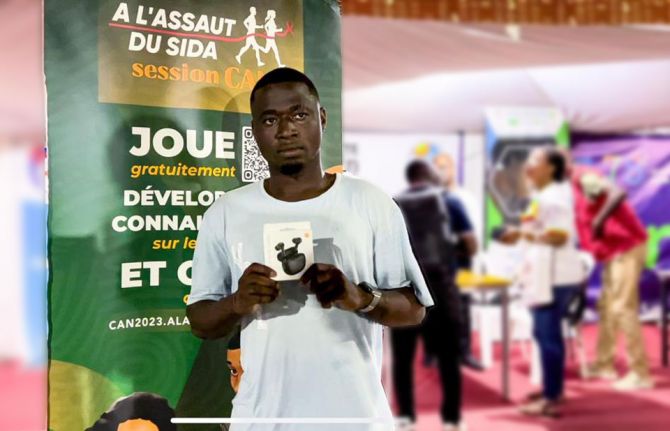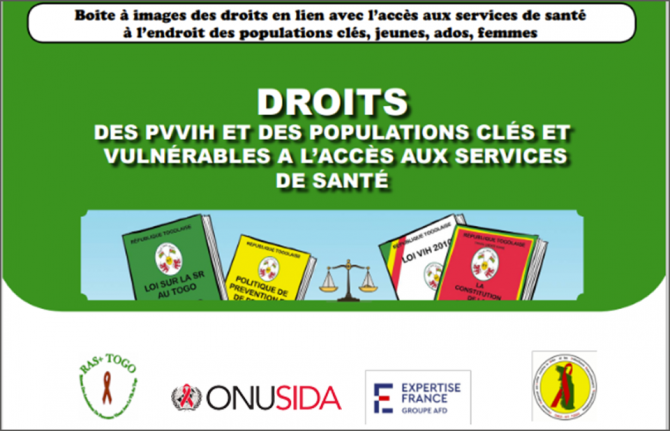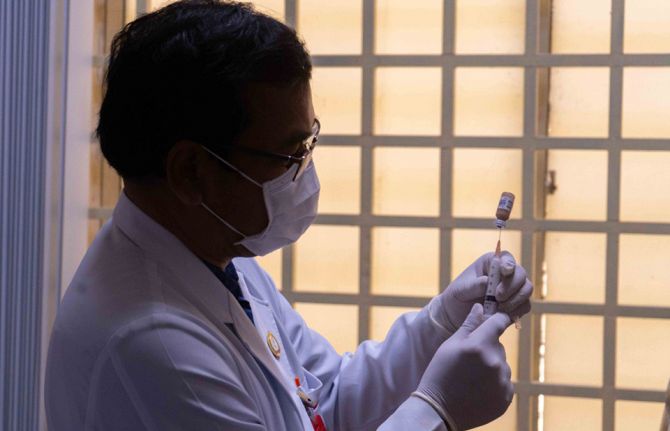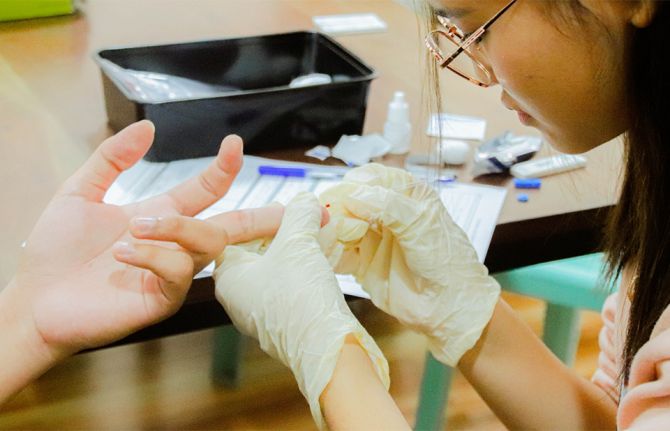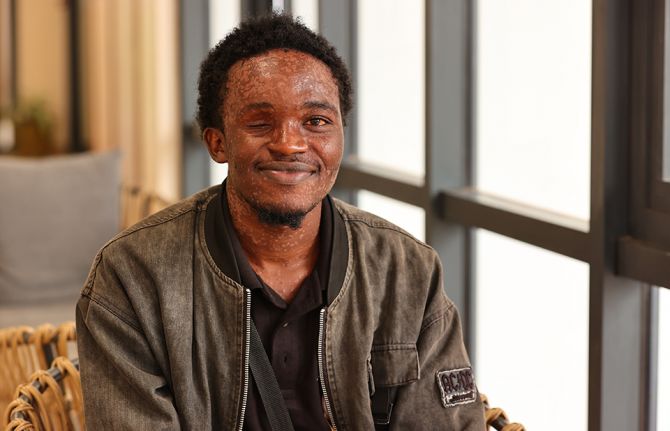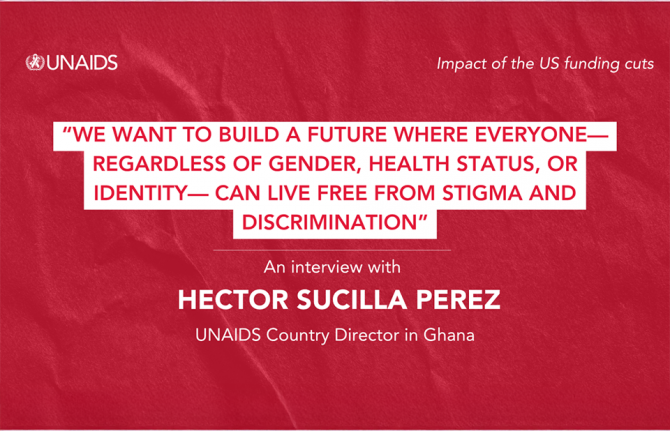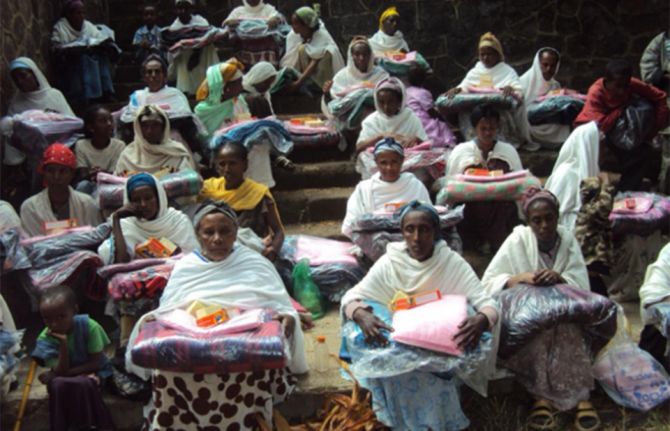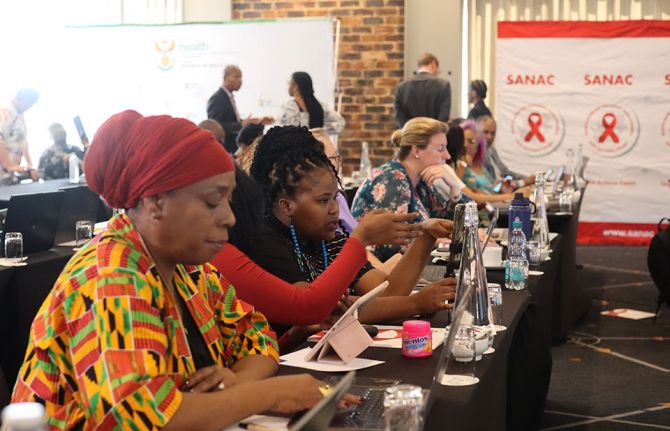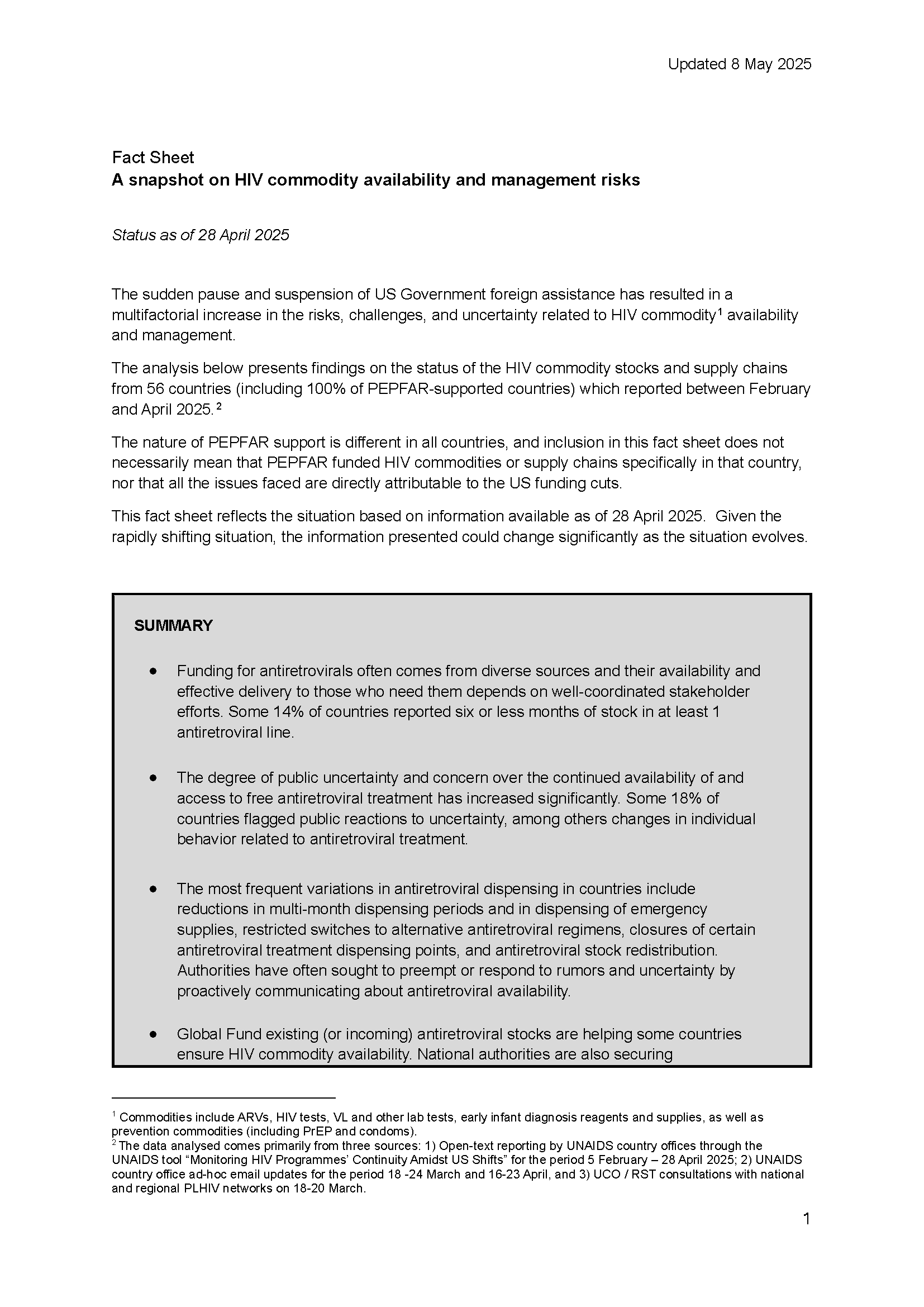
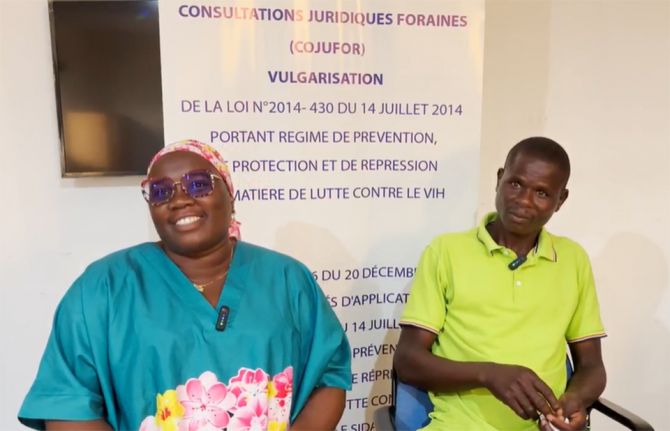
Feature Story
Côte d’Ivoire advances toward Universal Health Coverage—Leaving No One Behind
19 May 2025
19 May 2025 19 May 2025The government of Côte d’Ivoire is transforming access to health services, including HIV services, in its commitment to achieve Universal Health Coverage (UHC).
The government has made UHC registration mandatory and nearly 60% of the population is already enrolled, demonstrating the country’s political will to build a resilient and equitable health system.
A central priority of the Government’s UHC agenda—supported by the World Bank, the Global Fund and UNAIDS—is to ensure that all people living with HIV, estimated at over 400 000 people, are fully enrolled in the national health insurance scheme. Special attention is being given to identifying modalities through which the poorest and most vulnerable people living with HIV will benefit from free coverage under UHC.
In 2022, UNAIDS conducted an evaluation of Côte d’Ivoire’s social protection system through the lens of the HIV response. This work informed the 2024–2028 National Social Protection Strategy, which now explicitly recognizes people living with HIV as a priority vulnerable group.
“This is an urgent plea—I want all people living with HIV to have free access to the UHC card because many people simply cannot afford to contribute. I’m calling on the government to cover their premiums,” said Tinhidé Adéline, Community Counsellor.
Efforts are underway to integrate HIV-related services and products into the UHC benefits package. Over the past three years UNAIDS, in partnership with the Network of Organizations of People Living with HIV (RIP+), has mobilized communities and advocated with national authorities to ensure people living with HIV are enrolled in UHC, ensuring that stigma and exclusion do not stand in the way of health and dignity.
“UHC is a real opportunity for people living with HIV because being HIV-positive is often a barrier to accessing health insurance,” says Filbert Guéhi, Chair of the Board, RIP+.
UNAIDS, in collaboration with WHO, is also assisting RIP+ in developing a budgeted community-based strategy to sensitize and register people living with HIV in UHC to guarantee that services reach those most in need. This community-driven approach to UHC enrollment for people living with HIV represents a major step forward in ensuring equitable access to health care for vulnerable populations.
Advocacy continues to establish a sustainable national mechanism to automatically enroll the most vulnerable people living with HIV in the non-contributory Health Insurance Scheme. A two-year pilot initiative on this is currently being supported by The Global Fund and The World Bank. This is a vital step toward ensuring no one is left behind, and toward harnessing UHC as a powerful lever in the fight to end AIDS by 2030.
Ensuring full inclusion of people living with HIV in the roll out of UHC was a commitment made by the government at the annual session of the National AIDS Council in 2023 chaired by the Vice-President of Côte d’Ivoire Tiémoko Koné and in presence of the First Lady Madame Dominique Ouattara. This initiative is a cornerstone of the Government’s long-term strategy to transition towards a sustainable, nationally owned HIV response to end AIDS as a public health threat by 2030.
Region/country
Related

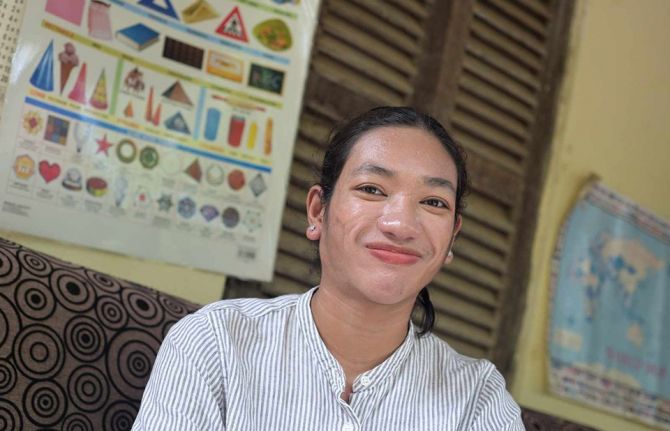


Feature Story
Championing the cause of women living with HIV in Cambodia
15 May 2025
15 May 2025 15 May 2025Em Ra disappears into the house twice, slipping past the shrine of flowers and incense by the front door. First, she brings out an old HIV magazine. She flips to a page of a small child, sitting on the back seat of a bike, looking straight into the camera. Next, she emerges with two framed photographs from a recent university graduation.
The girl and the graduate are her daughter, Sorn Vichheka, twenty years apart. In 2005, the year the bicycle picture was taken, Vichheka started taking medicines. At first, she didn’t know why. When she was 12, she learned that she was born with HIV.
“I am not sure when I accepted myself fully,” she says from her verandah in Meanchey, a commune to the south of Cambodia’s capital, Phnom Penh. “It was gradual.”
She looks out into a yard patrolled by chickens and surrounded by towering coconut trees. Under a shed in a nearby yard a baby sleeps in a hammock swung quickly back and forth by a string tied to its mother’s wrist. Vichheka’s sibling, who is HIV-negative, plays with the neighbours’ kids. They climb trees, dismounting onto the sides of concrete rainwater cisterns.
She traces her evolution from child to advocate. As a girl her mother was already involved in the HIV movement. Today Ra remains a community action worker with the Antiretroviral Users Association (AUA), helping other people at their treatment site. But as a teen, Vichheka was afraid of being found out.
“I started working for a company and did not disclose my status. At the same time, I was studying at the university. I was struggling with work and my studies, so I did not take my medicine regularly. Every time I went to the clinic co-workers would ask questions. They were curious to know what kind of health issue I had. I was very scared that people would know my HIV status,” she remembers.
Stressed, she ended up resigning from the job and dropping out of school. She soon began volunteering with an HIV organization. There, peers explained the concept of U=U (undetectable equals untransmittable) more clearly. She grasped that HIV treatment could not only keep her alive but make it impossible for her to pass the virus to others.
She also understood more clearly the issues women living with HIV were facing. Half of the people living with HIV in Cambodia are women. Five percent of women report recent intimate partner violence. Many are petrified about disclosing their status. Then there is the balancing act of self-care, family responsibility and economic survival.
“Some are housewives and need to take care of children so sometimes they don’t care much about their own health. Sometimes, because of the living conditions, they need to go to work to make an income to support the family. With this, they might miss some clinic appointments,” she explains.
Vichheka says that government social protection programmes offering free healthcare, nutrition support and cash transfers for women living with HIV have been vital. Community-led care is also required.
During the COVID-19 lockdowns when treatment access was interrupted, she joined the AUA. She participated in the community delivery of antiretrovirals for two years. After the project ended, she continued to volunteer. Between 2023 and 2024 Vichheka was driven, balancing volunteer work, daytime employment at an accounting company and evening study.
In 2023, the Cambodian Community of Women Living with HIV (CCW) — an organization that had been founded in 2008 but lost its financing in 2017— was revived thanks to small seed funding from UNAIDS for a U=U project.
That year, the Cambodian Network of People Living with HIV (CPN+) and International Community of Women Living with HIV Asia Pacific (ICWAP) mentored CCW to engage in a UNAIDS-funded Global Fund Grant Cycle 7 project. They successfully mobilized funding for 2025-2026. Vichheka was among three Cambodian participants in ICWAP’s Feminist School Leadership Training.
For the first time in over five years, CCW had a seat at the table. Vichheka was chosen by the members to be its coordinator.
“We set up a peer support group of women living with HIV who come together, share experiences and motivate one other. CCW also provides psychosocial support and connects women with job opportunities. The Global Fund investment will expand this work while conducting leadership training to build capacity among sub-national coordinators,” Vichheka explains.
Her leadership journey is a win against the odds. For her family it is also a full circle moment.
“I am really proud to have such a kind mother, taking care of me since an early age, knowing that I was born with HIV. She protected me all the time from outside society and kept me motivated,” she says.
Region/country

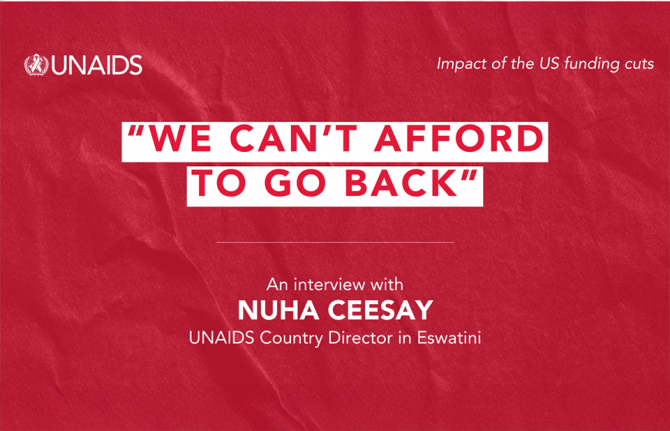
Feature Story
‘We Can’t Afford to Go Back’- UNAIDS Country Director on HIV funding cut in Eswatini
14 May 2025
14 May 2025 14 May 2025Eswatini, a country once described as the epicentre of the HIV epidemic with nearly 1 in 3 adults living with HIV in 2015 [adult HIV prevalence in 2015 was 31%]. But Eswatini managed to turn around its HIV epidemic, reducing new HIV infections from a peak of 21 000 per year in 2000 to 4 000 in 2023, a remarkable result, achieved with the support of US funding.
However, the sudden US funding cuts threaten to undo years of progress. We sat down with Nuha Ceesay, UNAIDS Country Director in Eswatini, to discuss the current situation, the impact on HIV services, and the way forward.
Q: How are US funding cuts impacting Eswatini’s HIV response?
Eswatini’s HIV response has been a success story, by transforming a crisis that once saw extremely high HIV prevalence rates, into a model of resilience and opportunity. But the recent US funding cuts, representing about half of the country’s HIV response budget, have left the people living with and affected by HIV in despair, the government was not notified and left unprepared, and the people working to end AIDS are in total shock. There is real concern that new HIV infections and AIDS-related deaths will rise, reversing years of hard-won progress. The cuts threaten not just HIV treatment and prevention, but also the broader health system improvements, data collection, jobs and empowerment of people living with HIV.
Q: What disruptions are being seen on the ground?
The effects are immediate and widespread. HIV testing services, the gateway to treatment, are now limited. With fewer people being tested, many may unknowingly be infected with HIV, missing the chance for early treatment and increasing the risk of further transmission. This could push annual new infections, which are currently around 4 000, even higher, and add pressure to already strained treatment resources. Stockouts of antiretroviral, lab test kits, and condoms are expected within months, and health worker layoffs are affecting service delivery and quality data collection. Primary prevention services, such as medicine to prevent HIV (PrEP), education campaigns, and voluntary medical male circumcision for HIV prevention (which is around 60% effective in preventing HIV) have also been scaled back or suspended.
We are also seeing a stop of the DREAMS programme which is a major setback for adolescent girls and young women, who are disproportionately affected by HIV in Eswatini. DREAMS provided prevention education, skills, and socio-economic support to young women. Its termination leaves them more vulnerable to infection and strips away resources that have been central to empowering this high-risk group. HIV prevalence among young women and girls aged between 15 and 24 years was 70% higher than among young men in Eswatini in 2023.
Read more about the impact on UNAIDS website
Q: How is UNAIDS responding to these challenges?
UNAIDS is working closely with the government and partners to continue the work of developing and implementing the HIV Sustainability Roadmap. This will help Eswatini’s HIV response to gradually shift from being reliant on international aid to increasing its domestic funding which will lead to the government taking full ownership of its HIV response. The first phase of this roadmap has already been launched, focusing on building resilience and long-term solutions.
UNAIDS has also worked closely with the Ministry of Health and partners to map the impact of the funding cuts, identify service gaps, and strategize on mitigating disruptions. Collaboration with the Ministry of Health, UN partners, and civil society remains central, but the transition to sustainability is a complex and gradual process.
Q: What’s your message to the international community?
The successes that we celebrate in the HIV response are built on mutual accountability and global solidarity. That’s what enabled countries like Eswatini to shift the narrative-from a crisis by leading a response that brought down new HIV infection to 4 000 compared to when new infections were as high as 21 000.
It is therefore devastating to see all the hard-won gains being reversed at this stage. This is the moment we need to come together in solidarity and in partnership to accelerate our collective efforts.
Ending the epidemic is like a marathon. We have run the race many miles, but the end is what matters. If we cannot reach that finish line, it means we have not completed, and we cannot afford that.
The Joint United Nations Programme on HIV/AIDS (UNAIDS) leads the global effort to end AIDS as a public health threat by 2030 as part of the Sustainable Development Goals.
Following the US stop work order in January, UNAIDS is working closely with governments and partners in affected countries to ensure that all people living with or affected by HIV continue to access life-saving services.
For the latest updates, please visit unaids.org
Related resources
Watch: "Access to prevention services no longer available", Nuha Ceesay, Eswatini UNAIDS Country Director
Watch: UNAIDS actively working on forward planning with governments, says Eswatini country director
Watch: "From crisis to opportunity," says UNAIDS citing Eswatini HIV response
Region/country
Related

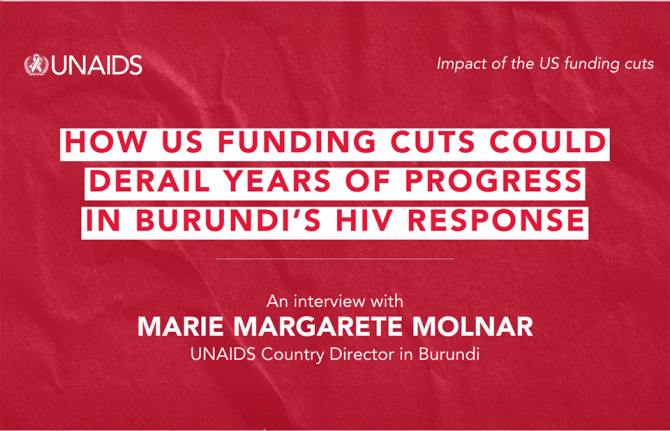
Feature Story
How US funding cuts could derail years of progress in Burundi’s HIV response
14 May 2025
14 May 2025 14 May 2025Q&A with UNAIDS Country Director in Burundi
International aid is shrinking, and countries are increasingly burdened by the need to prioritize debt repayment over essential services, including healthcare. This shift has left vulnerable populations more exposed, with the abrupt funding cuts by the United States throwing the HIV response in many countries into chaos. Burundi, unfortunately, is no exception. Across the country, HIV services have faced severe disruptions. Clinics are reducing their services, staff are being laid off, and thousands of people living with HIV are at risk of losing access to critical treatment.
In this interview, Marie Margarete Molnar, UNAIDS Country Director in Burundi, explains how communities are being affected, how the health system is coping, and what must happen next.
Q: Can you describe the current funding landscape for Burundi’s HIV response?
Burundi’s HIV response relies heavily on international aid - 95% of its funding comes from donors, with the US government contributing 51% through PEPFAR. This support sustained 10 major projects covering HIV prevention, treatment, and care for both the general population and vulnerable populations. PEPFAR also provided support to community-led monitoring projects and critical data system information.
Q: How have the recent US funding cuts affected these programmes?
Out of the 10 PEPFAR-funded projects, three were not eligible for the US waiver and had to stop operating. Some of the remaining seven, although eligible, could not resume their activities due to delays and financial uncertainty. As a result and based on an assessment conducted during the first month of the pause, at least 10 000 people living with HIV—who were among the 79 000 currently under treatment—have been directly affected. These individuals risk losing consistent access to medication and support services. In addition, 167 health professionals have lost their positions. These include doctors, nurses, psychologists, lab technicians, and community health workers—many of whom were directly providing HIV services. Financially, the immediate PEPFAR cut represents approximately US$ 6.5 million from the annual PEPFAR envelope of US$ 25 million for HIV in Burundi.
Q: What does this mean in practical terms for people on the ground?
Burundi had almost reached the 2025 ambitious targets: 95% of people living with HIV who know their HIV status, of whom 95% are on treatment and of the people on treatment 95% are virally suppressed. This was the result of strong collaboration between the government, civil society organizations and partners. The country was even recognized with an award. But now the third 95, on viral suppression, is declining because some people can no longer access viral load testing or follow-up services. If the situation continues, there is a high risk of an increase in new infections and a weakening of the entire HIV response system.
Q: What steps have the government and partners taken so far to respond to the crisis?
The government and partners acted quickly. UNAIDS conducted consultations during the first two weeks of February with key stakeholders. These consultations identified the scale of the impact and led to a series of recommendations that were shared with the Government and partners. The Ministry of Health together with UNAIDS and WHO held a two-day workshop with the PEPFAR implementing partners and civil society to understand how the cuts affected budgets, staffing, services, and beneficiaries and to brainstorm on rapid mitigation measures. As instances, it was recommended carrying out field missions to visit treatment sites and assess how services were coping without US support, forming a crisis response group and developing a national contingency plan. The government also began to identify treatment sites facing ARV shortages and organized a drug quantification workshop after PEPFAR-supported partners could no longer lead it.
Finalizing the HIV Sustainability Roadmap has also become a top priority. The roadmap is intended to guide how Burundi can finance and manage its HIV response without relying so heavily on external donors. We also discussed modeling different scenarios, from best case to worst case, based on whether funding returns or disappears entirely. These models would help us plan, reprioritize, and adapt strategies accordingly. We are also using the UNAIDS Rapid AIDS Financing Tool (RAFT) to get detailed data on how the funding cut is affecting commodities and staffing across the country.
Q: Is the government prepared to increase its contribution to its national HIV efforts?
It’s trying. Previously, funding for antiretroviral treatment was split between 76% from the Global Fund, 15% from the government, and 9% from PEPFAR. The government has now committed to covering partially that missing 9%. That shows political will. But it’s not just about medicine. It’s about health workers, community programmes and lab capacity. Burundi will need to restructure its approach by, for instance, integrating HIV into broader health and social protection systems, and significantly increase domestic health funding to reduce dependency, but this is difficult given the country's economic constraints.
Q: What’s your message to the international community?
Burundi is a fragile country facing multiple crises—economic instability, fuel shortages, emerging epidemics, and an influx of refugees from neighboring Democratic Republic of Congo. Despite these challenges, the country has made significant progress towards ending HIV, thanks to sustained investment in health including the HIV response. The risk now is losing these gains. Continued support from international partners is essential, not just for health but for the country’s overall development. At the same time, the Burundian government must increase its commitment to health funding. Only through global solidarity and strong political will can Burundi hope to end HIV by 2030.
The global community must understand that this is more than a budget line. It’s about lives, stability and global health security.
The Joint United Nations Programme on HIV/AIDS (UNAIDS) leads the global effort to end AIDS as a public health threat by 2030 as part of the Sustainable Development Goals.
Following the US stop work order in January, UNAIDS is working closely with governments and partners in affected countries to ensure that all people living with or affected by HIV continue to access life-saving services. For the latest updates, please visit unaids.org
Related resources
Watch: Sustainability now a crucial issue in the HIV response
Watch: Multiple crises affecting Burundi
Region/country
Related

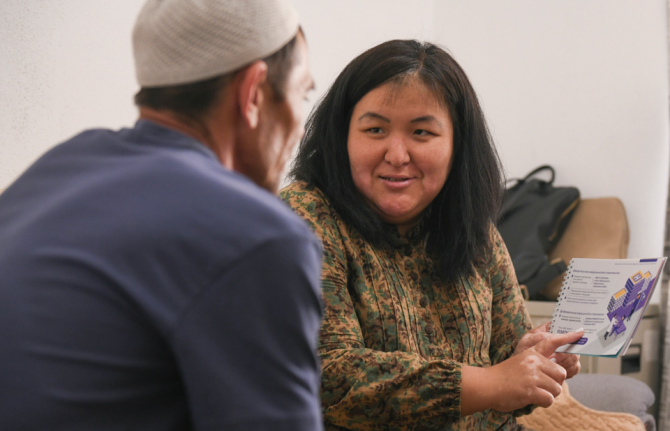
Feature Story
Community-led HIV services under threat: global networks and UNAIDS track the impacts of the US funding cuts
13 May 2025
13 May 2025 13 May 2025Community-led organizations are the backbone of the HIV response in many countries, providing access to HIV services for key populations, advocating for human rights and monitoring the HIV response. However, data collected by community-led organizations shows mass shut-downs of life-saving, peer-led services, significant – or total – budget cuts, staff lay-offs and rising levels of stigma, discrimination and mortality rates.
Two new key population-led reports, one by Global Black Gay Men Connect (GBGMC) and another by the International Network of People Who Use Drugs (INPUD), document the consequences of the US President’s Executive Order in January 2025 which froze all US foreign assistance. These reports highlight how services led by and for key populations are facing deep uncertainty about their future due to the funding cuts and loss of staff.
In its Frozen Out report, GBGMC found that 36% of partners supported by the US President’s Emergency Plan for AIDS Relief (PEPFAR) shut down within one week of the Executive Order. Another 19% said they could not operate beyond one month without renewed support. Similarly, INPUD’s report The Human Cost of Policy Shifts describes significant disruptions across harm reduction programmes. Nearly half (45%) of the organizations surveyed reported major budget losses, and one in four lost between 75% and 100% of their harm reduction programming. Critical services including peer-led outreach, HIV and hepatitis C testing, opioid agonist therapy, and overdose prevention have been disrupted.
A cascading crisis
The GBGMC report states that nearly 93% of key population-serving partners in Kenya reported experiencing full or partial service shutdowns. In Nigeria, every PEPFAR implementing partner providing services to key populations was reportedly affected. Across Kenya, Uganda and Nigeria, an estimated 2.2 million people have lost access to key population-focused HIV prevention services.
The report also warns that even short-term interruptions can have life-threatening consequences. Each day, an estimated 200,000 people rely on receiving their HIV treatment through US government-funded sites. Interruptions risk treatment failure, HIV transmission and the emergence of resistance to HIV medicines. Prevention efforts are also at risk, with US government funding supporting nearly 90% of global pre-exposure prophylactic (PrEP) initiatives.
“The PEPFAR funding freeze has led to the closure of numerous organizations and the disruption of essential HIV prevention services, leaving millions at risk. Immediate action is imperative to restore funding and protect key populations from further harm,” says Micheal Ighodaro, Executive Director of GBGMC
Impacts on organizations led by people who use drugs
INPUD’s report, The Human Cost of Policy Shifts, provides a detailed picture of how harm reduction services have been devastated by the US funding cuts. Based on a global rapid assessment of 101 respondents, the report reveals that nearly half lost between 26% and 100% of their harm reduction budgets, and 23% lost more than three-quarters of their funding.
The most disrupted services included peer-led outreach (41%), legal and human rights support (36%), HIV testing (35%), services for women who use drugs (33%), and overdose prevention (25%). The consequences for individuals and communities have been severe. 47% of organizations reported that people are now going without harm reduction supplies such as sterile syringes and naloxone, and 46% said people are relying on underground or informal networks for access. 30% observed increases in overdose deaths. Additionally, 62% of organizations documented rising stigma and discrimination against people who use drugs.
The report also highlights a particularly stark impact on women who use drugs. Of the 54 organizations that previously offered tailored services for women, 68% halted outreach, and over a third had to reduce or close services altogether.
“While increasing overall funding is important, it is equally vital to ensure that organizations led by people who use drugs receive targeted support to run harm reduction services that effectively address their communities’ unique challenges and needs," says Anton Basenko, Executive Director of INPUD
Heightened stigma and structural risks
Even before the funding cuts, key populations faced legal and social barriers
including criminalization, discrimination, and denial of services. According to reports gathered through UNAIDS’ dialogues with global and regional networks, these challenges are now intensifying. Community organizations have documented a rise in harassment, hate speech and healthcare discrimination. In some countries, specialized clinics are being “mainstreamed” into general health systems without adequate training or protections ensuring safe access.
UNAIDS’ response and coordinated action
Since February 2025, UNAIDS has been convening biweekly virtual dialogues with global key population networks, civil society advocates and international partners to share updates, raise concerns, and coordinate efforts to protect HIV services. At the regional level, UNAIDS is also convening with networks and joining forces to document the impact of funding disruptions and shape collective responses. These engagements have informed UNAIDS’ advocacy and programming supporting the launch of tools like the Rapid Action Financing Tool, strengthening country-level tracking through the UNAIDS impact portal (launched in early 2025) and amplifying community voices at global forums such as the UN’s Commission on the Status of Women and the Human Rights Council. Through continued collaboration with country teams, regional networks, and civil society, UNAIDS remains committed to co-creating solutions and prioritizing community-led responses.
A call for urgent action
GBGMC and INPUD urge governments, donors, and development partners to take immediate steps to:
- Restore and increase funding for community-led and key population-focused services and establish dedicated funding streams for key population-led organizations
- Establish pooled emergency funding mechanisms to sustain prevention and harm reduction
- Ensure meaningful community engagement in funding, service design, and legal reform
- Protect peer-led HIV services, which are grounded in principles of dignity, safety, and equitable access
Related documents
Related

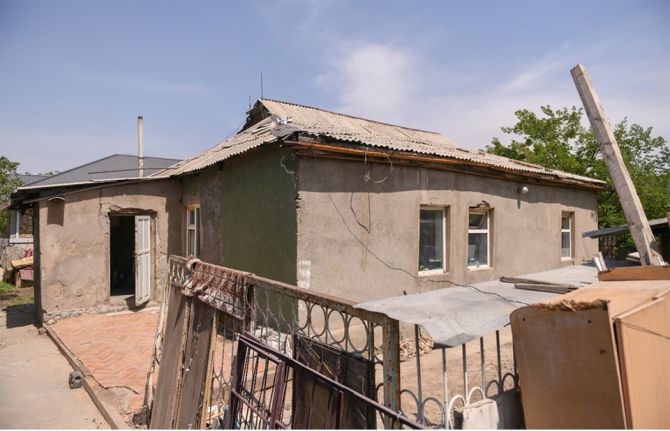
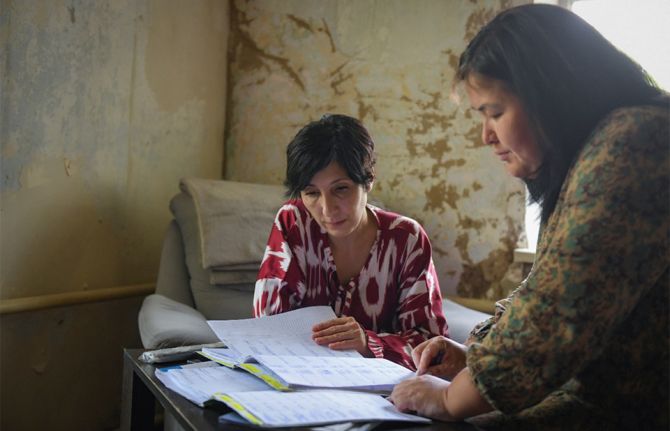
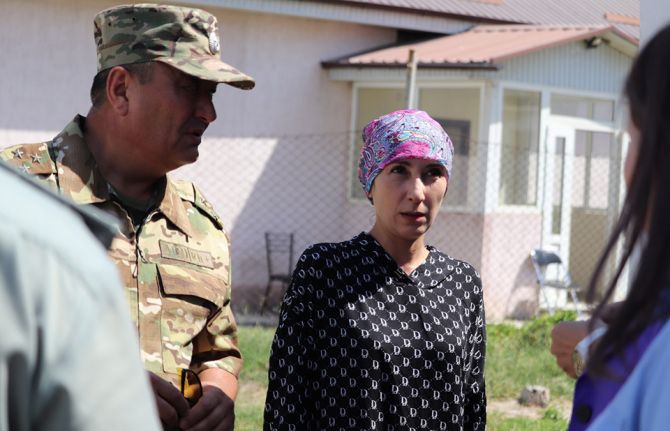
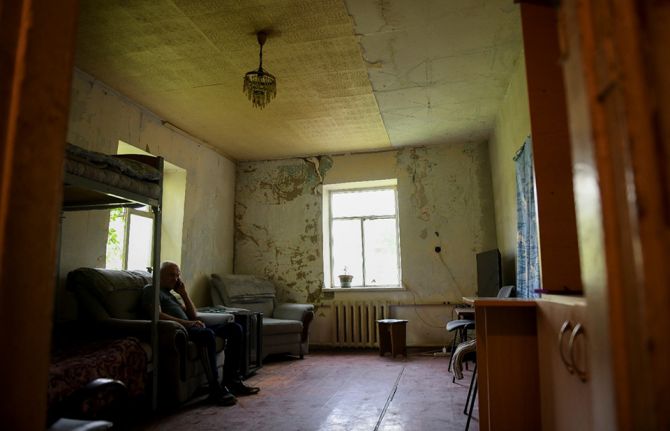
Feature Story
HIV services and social reintegration programmes for prisoners and newly released detainees in Kyrgyzstan at risk of collapse
08 May 2025
08 May 2025 08 May 2025On the outskirts of Bishkek, the capital of Kyrgyzstan, a small house converted into a shelter welcomes people recently released from prison. The shelter is funded by the Global Fund/UNDP project “Effective Control of HIV Infection and Tuberculosis in the Kyrgyz Republic.”
Madina Toktogulova, head of the public foundation Istikhsan, which supports the shelter, is preparing to welcome her clients.
For 25 years, Madina has worked with people in prison, people who use drugs, and those living with HIV and tuberculosis. As a community representative, she was at the forefront of establishing the country’s first grassroots initiatives, self-help groups, and community-based organizations. She played a key role in developing social support and rehabilitation programmes for people in vulnerable situations.
Together with a group of like-minded colleagues, she established the country’s first peer support groups in correctional facilities. They persuaded prison administrations of the importance of providing HIV prevention services, including harm reduction, to people in prisons; they built relationships with prison health professionals, social workers, and psychologists; implemented HIV prevention projects; and helped people newly released from prison who had no place to stay, clothes, or money to return home.
Dr Gulsara Kukanova, a physician at the FSIN hospital-polyclinic in Kyrgyzstan, stressed how vital organizations like Istikhsan are the moment people are released from prison as some stop taking antiretroviral treatment or relapse into drug use. “We partner with organizations like Istikhsan and witness people rebuilding their lives — finding jobs, reuniting with family. Offering hope to someone who has lost it is invaluable.”
Madina knows that without food, shelter, or ID, HIV treatment is not a priority. That’s why she advocates for a comprehensive approach to reintegration.
“People need more than just medical care. They need psychological support, help finding a job, restoring their documents. Non-governmental organizations, with donor support, play this essential role — helping people rediscover themselves,” she explains.
Istikhsan’s work focuses on supporting incarcerated women. Madina says women are more emotionally vulnerable, more affected by violence – the harsh reality of prisons, trauma, stigma, and self-stigma. They are more likely to give up on therapy and lose hope.
“Society forgives men more easily. Women with a prison history are judged more harshly. Maybe because I’m a woman, I feel their pain more deeply,” she says.
The organization is currently providing support to all women living with HIV in a nearby prison. Thanks to their efforts, more than 20 women have been able to restore their identity documents, dozens are receiving psychological and medical support, starting HIV treatment, reconnecting with children, finding jobs, and reintegrating into society.
But all of this is now at risk. HIV prevention efforts built over years through partnerships with government, civil society, and international institutions face collapse due to shrinking funding from key donors, including PEPFAR and the Global Fund.
According to Madina, a systemic approach to reintegration is impossible without cooperation between government institutions and civil society.
“We have a very good probation law that provides a legal framework for supporting people on the path to resocialization. However, as with any system, there are times when resources and human capacity are not sufficient to reach everyone in need. That’s when civil society can step in — in partnership with the state and within the framework of the existing legislation,” she emphasizes.
While the Kyrgyz government fully covers HIV treatment, there’s a real risk that essential social and prevention services — post-release support, reintegration, temporary housing, documentation help, hygiene kits — will be lost without external aid.
“The loss of funding could dismantle the entire support system for women living with HIV in prison. These programmes are not charity; they’re investments in resilient health and social protection systems that can operate independently. Investing now means building a future where everyone’s right to health is protected,” says Meerim Sarybaeva, UNAIDS Country Director in Kyrgyzstan.
“For the first time, we’ve created a model where probation services, prisons, and NGOs collaborate daily, so no one falls through the cracks,” says Chinara Maatkerimova, Programme Officer at UNODC in Kyrgyzstan.
“If we disappear, who will hear them?” Madina asks. But she’s determined to continue — even if it means starting over — to advocate for sustainable funding and rebuild a system where every person, regardless of their past, has a right to health and a future.
As of April 1, 2025, Kyrgyzstan has reported 14,609 cases of HIV. Of these, 61.8% were transmitted sexually and 27.8% through injection drug use. HIV is increasingly being detected among people outside of traditional key populations — a sign of the epidemic’s broader spread in the country.
Region/country
Related
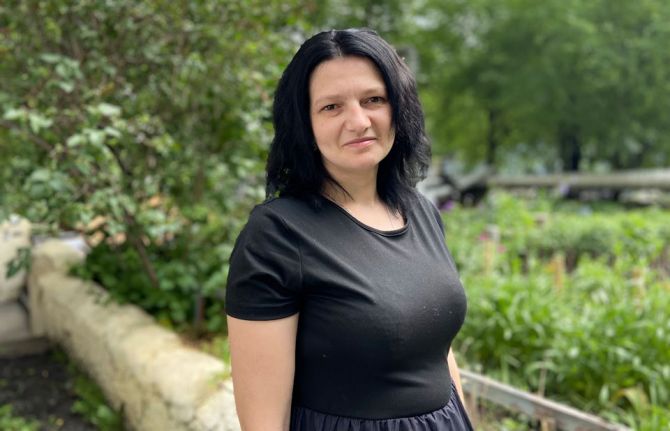 Women, HIV, and war: a triple burden
Women, HIV, and war: a triple burden

12 September 2025
 Displacement and HIV: doubly vulnerable in Ukraine
Displacement and HIV: doubly vulnerable in Ukraine

11 August 2025

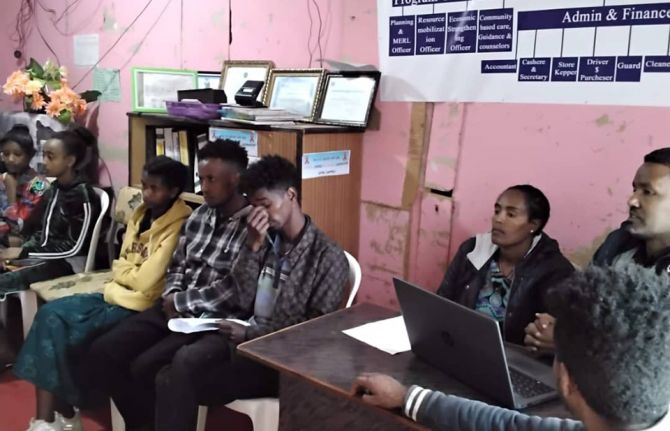
Feature Story
The Breaking Point: A Story from Ethiopia
06 May 2025
06 May 2025 06 May 2025In April 2025, silence fell over Bahir Dar. Once a lifeline for people living with HIV, key populations, and young people—as the US funding pause began to bite. Funding cuts disrupted services. A few held on without salaries but eventually, even they stopped showing up. Confused and anxious clients arrived to find the gates closed. Some waited. Others turned away.
The crisis quickly spread from Bahir Dar, where key population programmes came to a halt. Outreach workers, who had built trust door by door, were laid off. Fear took hold. Clients asked for extra medication, unsure whether services would return. Peer support groups vanished, and with them, protection against stigma and transmission.
"I often find myself overwhelmed with stress,” said a woman from a women led association. “If the medicine and other services stop coming, where will I go? I simply don’t have the financial means to afford the treatment I need.”
The data collected by the women-led association of people living with HIV is stark. For two months, no new clients have been enrolled in PrEP, the prevention prophylaxis taken orally that protects from HIV infection.
“One of my biggest concerns is the fear of not having access to condoms,” said a case manager from the women led association. “Without them, we know HIV can spread much more easily.”
In the face of this collapse, the UNAIDS Ethiopia team visited Bahir Dar and surrounding towns to document the impact firsthand. They spoke with organizations, youth groups, and people living with HIV. They visited what remained of the services and listened to voices that too often go unheard—adolescents, mothers, peer educators—people still holding the line, even as systems crumbled around them.
“I worry deeply about the spread of HIV,” said a female member. “Will medicine still be available? Will we still have access to viral load testing? If condoms run short, we risk seeing the virus continue to spread, along with other infectious diseases.”
"Without a financial budget, our members are left without the basics they need to survive; no food, medical care, or even hope," said the association manager. "They have families, they have children, and they rely heavily on this support. It would make a huge difference if members could access free medical treatment and hospital services. Today, many can't even afford one meal a day. Their health is deteriorating; their children are suffering. What they need most is dignity, food, and a fighting chance."
“There’s a real fear that if funding ends, everything else will follow—medicines, condoms, even access to medical personnel,” said a member from the women led association. “Without these, proper care becomes almost impossible.”
And yet, even in collapse, communities are refusing to give up.
Young volunteers have stepped in. They have formed informal networks, checked in on peers, and created WhatsApp groups to stay connected. Mothers banded together to support their children’s treatment. Youth collectives used community radio and shared airtime to spread critical information. Where formal systems failed, communities built their own safety nets.
Bahir Dar was both a breaking point and a wake-up call. It laid bare the fragility of systems built around a single funding stream—when the money stopped, so did the services, the trust, and the hope.
This crisis makes clear that resilience must be built in, not left for later. Emergency preparedness must be a core part of national HIV responses. Community-led organizations must be recognized as essential. And youth-led innovation must be scaled up—because it is young people who keep the response alive when everything else falls apart.
"Resilient communities are the backbone of the HIV response," said Tina Boonto, UNAIDS Country Director for Ethiopia. "When systems collapse, it is communities that hold the line. Their leadership, courage, and innovation are not optional—they are essential. Building lasting responses means putting communities first, not as an afterthought but as the foundation of everything we do."
HIV must remain central to humanitarian, development, and recovery agendas. The intertwined challenges of conflict, displacement, gender-based violence, and HIV demand integrated, people-centered solutions. This won’t happen if HIV is treated as an afterthought or reduced to clinical care alone.
The story of Bahir Dar shows what happens when systems fail, and what people do in their absence. It is a testament that resilience is forged in crisis by those most often left behind who still find ways to move forward.
Related resources
Region/country

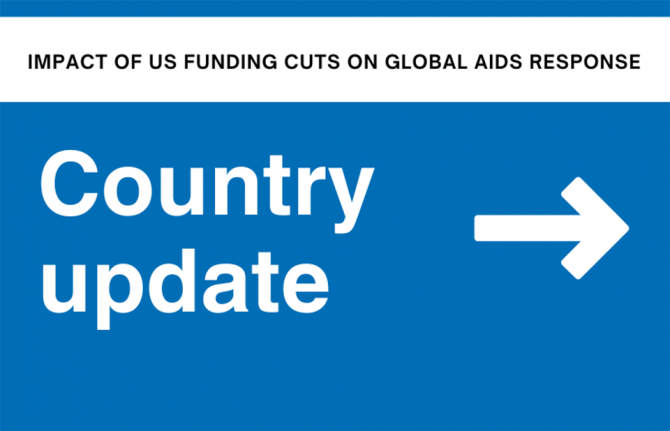
Feature Story
The impact of US funding cuts on HIV programmes in Democratic Republic of Congo
02 May 2025
02 May 2025 02 May 2025Documented impact on services
Stockouts of HIV medication and condoms are expected in the next 3-6 months.
The antenatal testing of pregnant women, delivery care for women living with HIV, early infant diagnosis and paediatric treatment services are all affected.
Data collection at some facilities/service points continues, but data quality control and data collation are affected
Human rights, key and vulnerable populations
There is disruption to PrEP services for adolescent girls and young women (AGYW), a reduced capacity of service delivery points for HIV prevention and a discontinuation of AGYW-specific outreach programs.
There is a limited availability of HIV testing services for AGYW, reduced availability of HIV prevention education and awareness campaigns, and reduction in the availability of counseling and social support services for AGYW.
All programmes on stigma and discrimination have stopped with key populations, AGYW, young people, people living with HIV and other populations affected.
Government convening, mitigation measures
The Ministry of Health has been convening impact assessment meetings, with a special commission set up for this purpose.
The ministry of justice has been leading an impact assessment on human rights violations and the protection of key populations. There have been consultations between the Ministry and organizations representing key populations.
The Ministry of Family and Child’s gender working group has conducted an assessment and a gender-based contingency plan is available.
Civil society impact, resilience and response
Civil society organizations in Haut-Katanga have conducted a risk assessment. Steps are also being taken to set up a public-private partnership with civil society organizations. Advocacy for the mobilization of local resources is underway.
Community-led organizations are at risk of closure or severe reduction in services.
There is an increased difficulty in accessing government or donor support, loss of funding for monitoring activities and a reduced ability to collect and report data.
The involvement of community-led organizations in policy design, advocacy, and work on societal enablers has been affected, resulting in a limited ability to advocate for key issues, a shift in focus due to funding constraints, and a reduced participation in policy discussions.
Service delivery by community-led organizations has been affected by the reduction or suspension of services, with an increased demand with fewer resources, loss of staff or funding cuts.
UNAIDS response
The MPox/HIV project for key populations is underway with partners in Kinshasa.
There is support for resource mobilization with a 2-year Department of Health project.
Support is being provided to the Ministry in charge of Gender and the Ministry of Human Development for the organization of a national HIV forum and mobilization of resources.
Advocacy with German and Canadian embassies, African Development Bank, World Bank and the EU to position the HIV response.
Data support is also being provided to assess the impact of the funding cuts on new HIV infections and AIDS-related deaths.
Related resources
Region/country
Related

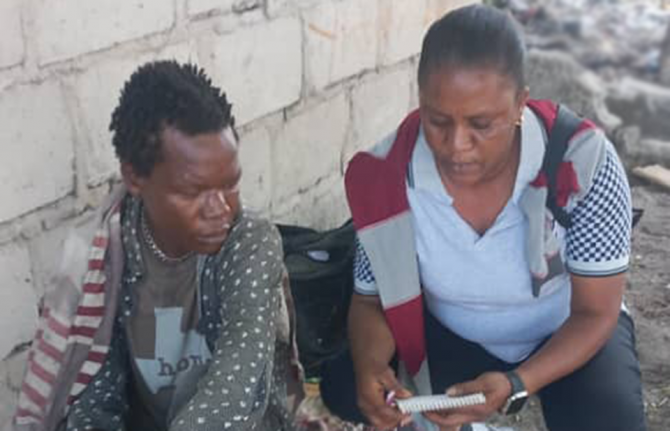
Feature Story
US foreign aid cuts puts the lives of people who use drugs at risk
05 May 2025
05 May 2025 05 May 2025Godfrey Swai is shaken. Since the end of January, the US aid funding cuts have meant that he can only afford for his staff to work a couple of hours twice a week compared to a full five days.
As the Executive Director of an organization called Methadone Family Against Drug Abuse based in Tanzania he has had to scramble. “Despite clinics being partly opened, our outreach in hotspots came to a halt,” he said. “The community is scared.”
In many countries, like Uganda, centres distributing opioid agonist maintenance therapy (OAMT), also known as medically assisted treatment, closed for a month. OAMT is often prescribed as oral medication to alleviate withdrawal symptoms and reduce injecting drug use, which in turn lowers the risk of acquiring HIV. In 2022, the risk of acquiring HIV was 14 times higher for people who inject drugs than for people in the overall adult population.
“We know that disruption to OAMT is a threat to life,” said Catherine Cook, Sustainable Financing Lead at Harm Reduction International (HRI).
Banza Omary Banza, Director of Community Peers for Health and Environment Organization in Tanzania, agrees. “Fearing a stock out of methadone–the OAMT medicine–we have witnessed people returning to heroin use and hitting the black market,” he said.
A setback that has a myriad of repercussions.
According to a recently published survey by International Network of People who Use Drugs (INPUD) there has been large-scale suspension of outreach and harm reduction programmes, including needle and syringe distribution, HIV and hepatitis C testing, overdose prevention and legal support services.
“The hardest hit has really been the peer-led outreach,” said Aditia Taslim, Advocacy lead at INPUD. “Three months later no alternative solutions have been put in place. It’s like we are being erased from the HIV response.”
For harm reduction advocates this crisis isn't just financial, it's profoundly human.
“Peers and peer outreach have been the backbone of the harm reduction response," said Juma Kwame, Director of Tanzania Network of People who Use Drugs (TANPUD). “Without people seeking out their peers you don’t have linkages to treatment to health services or to recovery.”
Team leader at a network of women who use drugs in Dar es Salaam, Grace Mbalawa, said that most people living with HIV who use drugs have little income or a stable home, so the loss of support programmes has upended their lives.
“They no longer have a safe space and many are stretching out their HIV treatment by skipping days in case they can no longer get their medicine,” she said. People living with HIV must take daily treatment to stay healthy and suppress the virus. In addition, when the viral loads of people living with HIV are suppressed, sexual transmission of HIV does not occur.
International donor funding comprised 67% of total harm reduction funding in 2022. Most of the money went towards HIV prevention programmes for people who inject drugs. The US President’s Emergency Plan for AIDS Relief (PEPFAR), a decades-long initiative, supported OAMT to 27 000 people in seven countries (India, Kenya, Kyrgyzstan, South Africa, Tajikistan, Tanzania and Uganda). In many cases these were and are the only services available. They also supported harm reduction programmes in Mozambique, Myanmar and Kazakhstan.
Many fear the loss of funding threatens to undermine human rights and marginalize communities already battling stigma and years of neglect with women bearing a big portion of the impact.
“One in three people who use drugs are women but women only account for one in five people accessing services due to the stigma of being a woman using drugs,” said Ms Cook from HRI. “They risk having to admit drug use and face stigma, arrest, losing custody of their children or even violence from the wider community.” Any services tailored to women like the one Ms Mbalawa works for are key as are all peer-led services.
Ms Cook is concerned that if funding for communities and civil society support dries out, the entire harm reduction response may collapse. INPUD also warns that without immediate and strategic intervention, the world could witness a resurgence of HIV, hepatitis C, and overdose epidemics.
UNAIDS, UNODC and partners have been working with governments to encourage increasing domestic funding and mapping out sustainability plans. Central to these include having organisations led by people from the community participating as well as moving funds away from punitive approaches like criminalising drug use to reduce stigma, and inequalities.
“As countries look at new models for how to integrate specific HIV services tailored to serve the needs of people living with HIV or at risk of HIV, including people who use drugs, into general health services, this must include the integration of harm reduction services ” said Suki Beavers, UNAIDS Director of Equality and Rights for All. “And peer-led outreach is part of that equation.”
Mr Kwame stressed, “We need our voice to be heard so that people who inject drugs are part of the health agenda, and our needs are met.”
Related resources

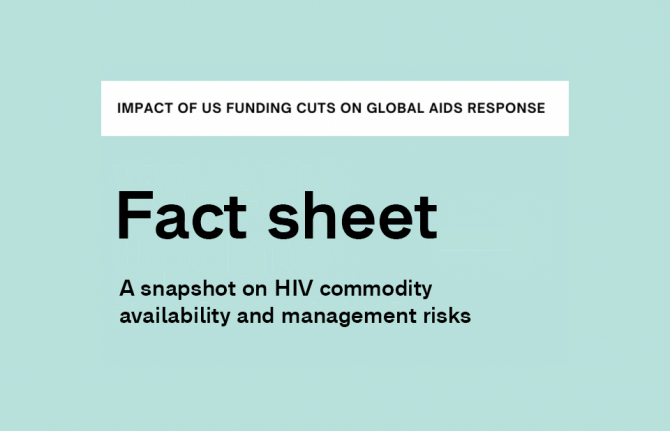
Feature Story
Impact of the US funding cuts: A snapshot on HIV commodity availability and management risks
01 May 2025
01 May 2025 01 May 2025The sudden pause and suspension of US Government foreign assistance has resulted in a multifactorial increase in the risks, challenges, and uncertainty related to HIV commodity[1] availability and management.
The analysis below presents findings from 56 countries (including 100% of PEPFAR-supported countries) which reported on the status of their HIV commodity stocks and supply chains between February and April 2025.[2]
The nature of PEPFAR support is different in all countries, and inclusion in this fact sheet does not necessarily mean that PEPFAR funded HIV commodities or supply chains specifically in that country, nor that all the issues faced are directly attributable to the US funding cuts.
This fact sheet reflects the situation based on information available as of 28 April 2025. Given the rapidly shifting situation, the information presented could change significantly as the situation evolves.
SUMMARY
- Funding for antiretrovirals often comes from diverse sources and their availability and effective delivery to those who need them depends on well-coordinated stakeholder efforts. Some 14% of countries reported six or less months of stock in at least 1 antiretroviral line.
- The degree of public uncertainty and concern over the continued availability of and access to free antiretroviral treatment has increased significantly. Some 18% of countries flagged public reactions to uncertainty, among others changes in individual behavior related to antiretroviral treatment.
- The most frequent variations in antiretroviral dispensation in countries include reductions in multi-month dispensing periods and in dispensing of emergency supplies, restricted switches to alternative antiretroviral regimens, closures of certain antiretroviral treatment dispensing points, and antiretroviral stock redistribution. Authorities have often sought to preempt or respond to rumors and uncertainty by proactively communicating about antiretroviral availability.
- Global Fund existing (or incoming) antiretroviral stocks are helping some countries ensure HIV commodity availability. National authorities are also securing supplementary domestic budget allocations to ensure HIV commodity availability and management.
- Despite the precarious situation faced by many community-led organizations because of the USG shift, they continue to play a central role in engaging and informing communities, addressing rumors, advocating for mitigation actions, and providing early warning on ARV availability, accessibility and cost.
- Significant disruptions affecting combination prevention commodities have been reported as a result of the USG shift. This is due to the dominant role played by PEPFAR in prevention commodity procurement, distribution or delivery in many countries. Some 23% of countries reported six or less months of condom or PrEP stocks.
- Around 21% of countries reported six or less months of stock in at least 1 HIV testing commodity. Careful monitoring of individualized country situations is necessary to mitigate any possible increase in stockout risks.
- Even when HIV commodities exist in-country, they may not always be reaching health facilities – creating patient-facing shortages that undermine trust in treatment continuity. Some 46% of countries reported supply chain management issues.
- The repercussions of the USG shift on the global HIV commodity markets should not be underestimated in the medium term. Sustained predictability in HIV commodity demand forecasts is essential to guarantee a stable supply, maintain prices, and ensure the availability of affordable generic medicines for national HIV responses.
[1] Commodities include ARVs, HIV tests, VL and other lab tests, early infant diagnosis reagents and supplies, as well as prevention commodities (including PrEP and condoms).
[2] The data analysed comes primarily from three sources: 1) Open-text reporting by UNAIDS country offices through the UNAIDS tool “Monitoring HIV Programmes’ Continuity Amidst US Shifts” for the period 5 February – 28 April 2025; 2) UNAIDS country office ad-hoc email updates for the period 18 -24 March and 16-23 April, and 3) UCO / RST consultations with national and regional PLHIV networks on 18-20 March.


